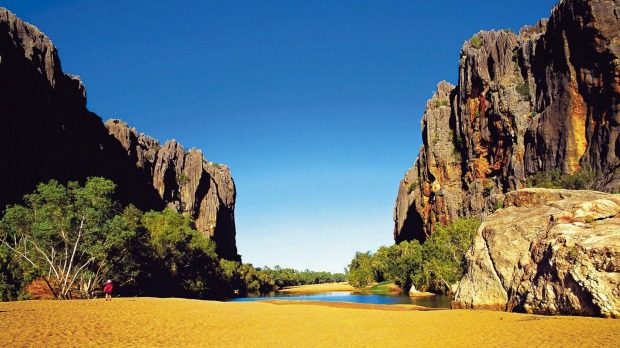
It's dusk on the eastern section of the Gibb River Road, 30 kilometres from our next overnight stop at Home Valley Station, when we hear a distinctive pop and what sounds like somebody sitting on a whoopee cushion.
"What was that?" asks my partner Sarah, who is driving the Prado rental carrying us, our 6- and 4 year-old girls, Mila and Freya, and a friend's 16-year-old daughter.
Before I can answer, the thud of the wheel rim against the dirt road tells us we've blown a tyre.
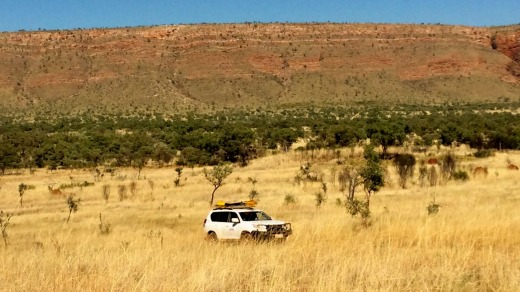
"Time to man up," I think, painfully aware that when it comes to mending punctures, I have nothing.
Half an hour later the light is nearly gone and we're still trying to jack the car high enough off the sand to remove the tyre when we hear the grumble of an oncoming truck.
As the ute slows down beside us, the demented Wolf Creek killer flashes through my mind.
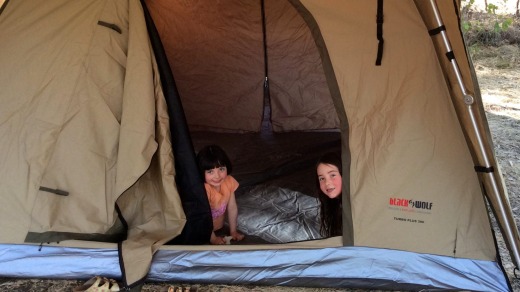
"Need some help?" asks the driver Jerry, winding down the window, as his off-sider Mike hops from the back.
It takes 20 minutes and some special bush skills, including driving the back wheels up onto rocks to achieve the necessary height and two blokes happily getting totally shrouded in red dust from tinkering beneath the car, to get us underway again.
We are five days through our week-long drive along the Gibb River Road, with two other families, when we are rescued by this show of remote Kimberley kindness.
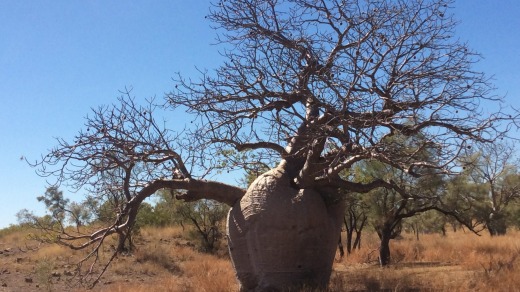
It's six months since the notion was first mooted at a wine-fuelled Sydney dinner of three families, including one jetting in from Poland – with kids aged 4-19 – "doing" the Gibb River Road. Hundreds of emails have been sent and dozens of calls made in the interim, the planning made tortuous by our need to travel during the Kimberley's busiest period and most accommodation and facilities being booked.
But, by the time we set off from Broome, one early July morning, everything is in place. We have two new seven-seat Prados from Broome Broome car rentals and, stacked on their roof racks, two enormous Black Wolf turbo tents – which reputedly go up in 10 minutes – and an array of hired camping gear.
About two hours later we are on the western section of the 660-kilometre Gibb River Road and, as we move toward our first stop at Windjana Gorge, I'm reminded of why we've come north in mid-winter to do this journey. A lost curl of wispy cloud drifts across an intense blue sky and, sprouting from the red-earth roadside, dozens of elephantine boab trees are gleaming silver in the morning sun.
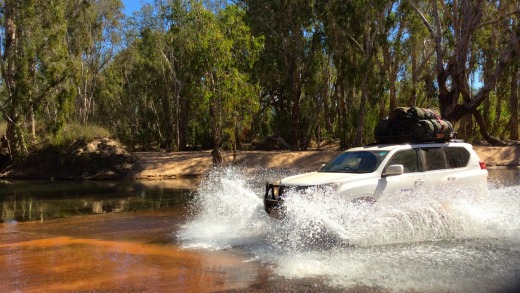
With its freshwater crocodiles basking on the sandy banks of Lennard river, 100-metre limestone walls amplified in its limpid pools and clouds of shrieking corellas bursting from its treetops, Windjana Gorge provides our journey with a theatrical opening scene. As we enter the 3.5-kilometre long canyon, the Poles stop in their tracks, their jaws slackening in seeming mimicry of the open-mouthed crocs, and my chattering daughters grow quiet.
I, meanwhile, am drawn to a large boulder, marooned in mid-creek, that's of great spiritual significance to local Bunuba Aborigines. It's spell is finally broken by a volley of watery arrows shooting skyward from the pool. The jets are fired by several striped Archer-fish, fiendishly trying to down a helicoptering dragonfly.
Our base for our first two nights is the APT's Bell Gorge Wilderness camp, a collection of tented cabins looking across the King Leopold ranges. The accommodation eases us gently into the Kimberley bush, with comfortable twin beds, hot showers and outdoor decks as well as an on-site restaurant.
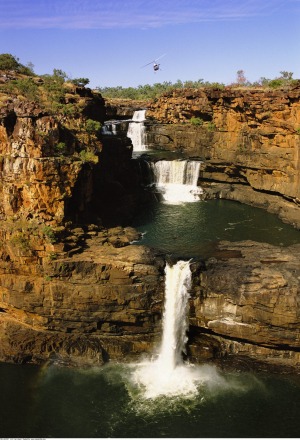
On our first evening we gather around the campfire as entrees of Thai-style chicken meatballs are served, then move inside for a main of grilled barramundi. The day's all been too much, though, for our youngest, Freya, who falls asleep, mid-mouthful, in my arms, forcing Dad to polish off two gigantic chocolate mousses.
Our second day is spent at two of the western Kimberley's most impressive gorges, Bell and Lennard.
Bell Gorge is reached via a 30-kilometre access road and short walking trail alongside a trickling creek. The track emerges above the horseshoe-shaped gorge and its falls, which tumble over a series of ledges into a dusky-green pool. We climb around a knoll and descend to the far side of the waterhole, which, in the early morning we have almost to ourselves. We swim to beneath the falls, dousing ourselves under their gush of cool water before drying off on ledges all around this spectacular bowl gouged from the King Leopold Ranges.

It's not long before school holiday crowds build at Bell Gorge, so we move on. We meet just one other couple on the one kilometre to Lennard Gorge, probably because traversing the escarpment to reach it is hard-going in the midday sun. But the few teenage grunts and piggy-backs for small people are worth it for the giddying views down into the skinny chasm, sliced deep into the sandstone by the Lennard river.
The following morning we track 95 kilometres south of the Gibb River Road to Mornington Wilderness Camp, a 322,000-hectare wilderness area owned by the Australian Wildlife Conservancy, offering accommodation, camping and a restaurant. With a mission to establish havens for native animals and to control feral species, the AWC operates 23 sanctuaries across the continent. Numbers of endangered mammals like the Greater Bilby and the Numbat have significantly increased in those protection zones.
For us, Mornington is a first chance to erect our "Turbo" tents – three adults blundering for 40 minutes to put one up but cutting that in half by the second – in a shady grove beneath an escarpment, and, again, to be remarkably well-fed in an isolated location.
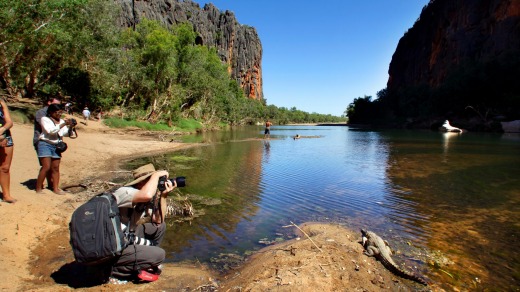
With two less-frequented gorges, Dimond, down which we paddle three kayaks one sparkling morning, and Sir John, where we watch the Fitzroy river collect painterly reflections at sunset, Mornington is loved by us all.
Nor is the wildlife here merely the subject of evening slideshows, as we discover on return to our campsite one night. Having persuaded the three Poles, notwithstanding long-running jokes about Australia's murderous animals, to follow my example and sleep under the stars in swags, I chuckle when I hear one of them say:
"Zer iz a snake."
"Yes and there's a crocodile in my swag," I snort dismissively.
"No, zer eez a snake," he repeats calmly, as his wife and son shout something loud in Polish, "a zery beeg snake."
Sure enough, upon inspection with a torch, a chunky greeny-brown serpent is revealed among us, sliding under one of the Prados. Hurrying to the opposite side I spotlight it gradually disappearing up the wheel hub.
Later, with the help of Mornington's chef cum snake-wrangler, we open the bonnet to reveal a venom-less, but still imposing, 3.5m olive python looped around the warming engine.
All credit to the Eastern Europeans, although I retreat to the tent once the snake is dispatched up the nearby hill, they return to their swags for an authentic Aussie bush experience. At dawn, I find them still fully enveloped, but thankfully breathing, inside.
By the time we have our puncture two nights later, we've learnt that adventure lies at the heart of any journey along the Gibb River Road. That, school holidays or not, this is a remote and occasionally rough thoroughfare, demanding long hours of driving rewarded by some of this continent's most unforgettable scenery.
From the yawning Windjana and Bell chasms in the west to intimate palm-fringed pools like Galvans at the route's core to the sweeping Cockburn ranges in the east, the Gibb River Road unfolds in a panoply of semi-desert plains, chapped mesas and waterfalls pulsing through gorges secreted within massive rock outcrops. It's a landscape smashed and fragmented by the eruptive wet-season flooding of rivers like the Fitzroy in the west and the Drysdale to the east and distending creeks throughout the central Kimberley plateau.
Eight days on the Gibb River barely does this frontier justice, and necessitates us seeing sights like Mitchell Falls – tumbling off the edge of the plateau a day's drive down the offshoot Kalumburu Road – by scenic flight from Drysdale River Station, our final campsite.
Yet it's an epic expedition packed with immersive experiences, from encounters with wildlife and Kimberley characters to dips in sublime natural swimming holes. By its end, our seven-year old Mila has grown visibly in confidence, at the front on treks and leading the call to "swag-it", joining her Dad by the campfire on our penultimate night.
Trundling happily into the inky evening after our puncture we learn another lesson from the Gibb River Road. That the unexpected is not only likely but should be well, anticipated.
Now at the helm and driving deliberately slowly, I see the white eyes of a kangaroo staring into our headlights, 50 metres ahead. I reduce speed to 10km/h and wait for it to slink off into the bush before edging forward.
A second later there is an almighty thump on the nearside passenger door.
The startled roo escapes, to our huge relief, with a very sore nose. But having eschewed paying the expensive excess on our rental vehicle and forgotten to renew our travel insurance, the unavoidable accident puts a $3000 dent in our holiday budget. While a credit card covers that, everything else on this Kimberley adventure is, however, priceless.
Daniel Scott was a guest of Tourism WA and North-West Tourism and was assisted by Broome Broome car rentals, Home Valley Station, Black Wolf Adventure Gear and Broome Hire Centre.
australiasnorthwest.com
Qantas have direct flights to Broome from Melbourne and Sydney during the winter season (April-October). Qantas.com.au
Broome Broome car rentals has Toyota Prado 4WDs for $156.50 a day for 7- to 13-day hires . Black Wolf turbo tents are durable, super-quick to erect and perfect for this adventure . Broome Hire Centre rents out all camping equipment .
APT Bell Gorge Wilderness Lodge has twin tented-cabins for $590 per night, including breakfast and three-course dinner, with two nights and longer discounted .
Mornington Wilderness Camp has safari tents for $295 twin-share (kids 3-12 $145) including breakfast and two-course dinner, and camping for $18.50 per person per night (kids $8). .
Drysdale River Station has accommodation, camping from $15 and homestead restaurant. Scenic flights run from Drysdale to Mitchell Falls, from $399 per person .
Home Valley Station has a range of accommodation including luxurious Grass Castles ($320 per night including breakfasts), eco-tents ($150), guesthouse rooms ($235) and camping .